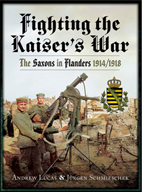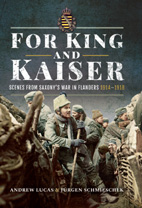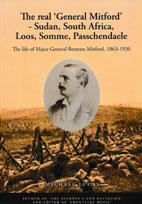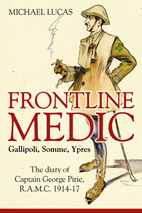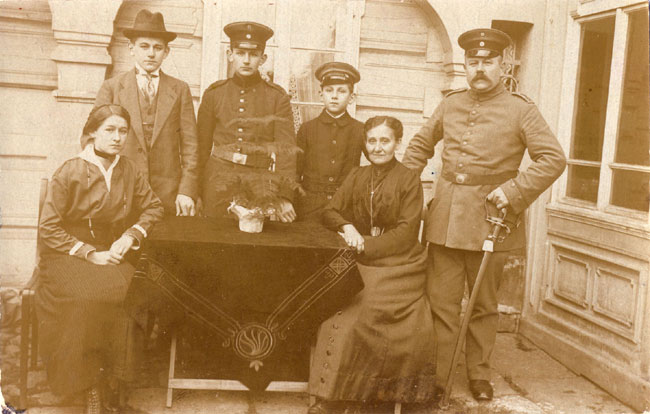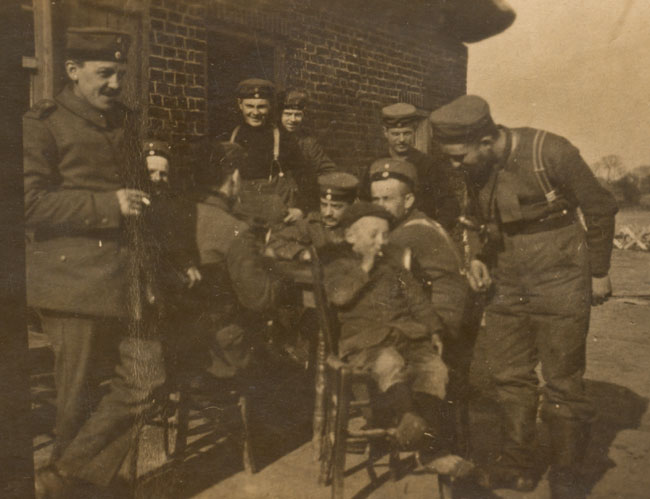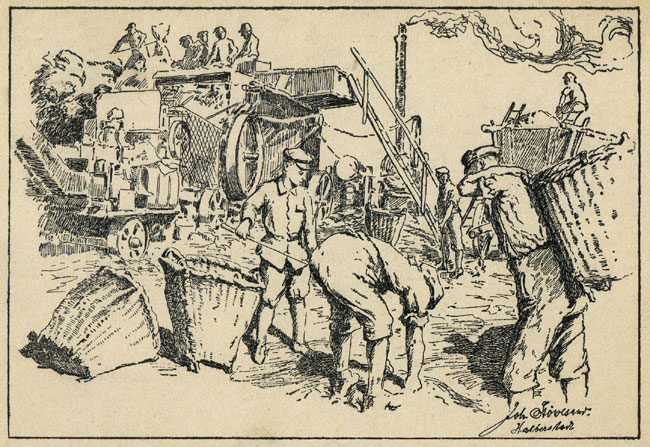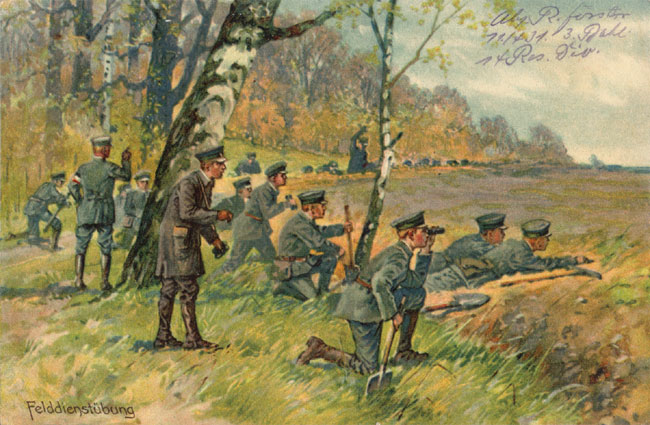Today I wish to introduce an unusual and elusive character who briefly appears in For King and Kaiser, and share some further evidence on the disturbing phenomenon he exemplified.
On 28th October 1914 our featured diarist Major Alfred von Heygendorff (having taken command of Reserve-Infanterie-Regiment Nr.245 in the midst of the ongoing battle, a mere four days earlier) endured "a dreadful day" at Becelaere. The village was subjected to intensive bombardment by the British artillery and many houses set ablaze. The major and his regimental staff took a personal part in dousing a dangerous (small arms) ammunition fire, and were obliged to retire to the cellars of a brewery after surviving a near-miss in their own headquarters. Under the relentless bombardment the entire regiment was forced into cover for the day, leaving "about sixty corpses" from the previous fighting still unburied.
After describing this grim situation at some length, the major changes subject and unexpectedly mentions two of his subordinates who have won his affection:
My current orderly Landwehrmann Müller frets over me most touchingly, he cares for me like a son. Lately I met a 15-year-old boy scout named Fritz Lehmann, who lies in the firing line, joins in the shooting, has a textbook fury toward the English, fetches food and transports the wounded. Now he has got himself a uniform from the dead and received the Iron Cross.
He mentions Lehmann again three days later:
Among the wounded is a 15-year-old boy who has taken a head shot – not my friend Lehmann.
By all law and social convention, these boys should not have been anywhere near the front. The active service requirement established in peacetime was from the age of twenty, and the minimum age for peacetime volunteers was seventeen. Seventeen was also the minimum age for service in the Landsturm, which would subsequently call up many of the less enthusiastic teenagers. As in all combatant nations, many teenagers undoubtedly lied about their age in order to volunteer.
The regimental history of RIR 241 includes a personal account entitled "How I became a Soldier" by one Kurt Keller, who in summer 1914 had been an eager sixteen-year-old would-be infantryman. On 31st August he queued up at the Grenadierkaserne (the barracks of either LGR 100 or GR 101) in Dresden-Albertstadt, only to be rejected as "too young" upon claiming to be seventeen. Soon after he tried again, claimed to be nineteen and was accepted by the same medical officer who had rejected him (so he claims) mere minutes before.
As far as the newly raised RIR 241 and the Saxon military bureaucracy were concerned, Keller was nineteen. There were certainly many more like him among the Kriegsfreiwillige who made up such a large proportion of the XXVII. Reservekorps. The case of Fritz Lehmann however was quite different - not only was he (at least according to one of our sources) a mere fourteen years old, but also universally known to be underage. This was possible because he was not only not officially present at the front, but also not an official member of the armed forces.
Above: Patients from an assortment of units at a field hospital in Flanders, early 1915 (probably during the Second Battle of Ypres). The young man seated on the left in the front row is a Saxon infantryman of RIR 245, sporting the hard-wearing 'Manchesterhose' (corduroy trousers) much favoured by the Württemberg regiments of his division. This is the only photo I know of which shows a Saxon wearing such trousers, despite having amassed hundreds of images from the Saxon elements of the three mixed Saxon / Württemberg divisions (54.RD, 58.ID and 204.ID).
The man standing on the left is another Saxon from IR 105 (30.ID / XV.AK). Note also the Unteroffizier in the back row wearing a captured Belgian cap.
Above: Peacetime pupils of the Saxon Unteroffiziers-Vorschule (NCO preparatory school) in Marienberg, posing in front of a still extant local memorial dating back to the Napoleonic Wars. After completing compulsory education at the age of fourteen, prospective career soldiers (often the sons of the NCO class) could pursue a two year course at this institution, providing general education and physical development. Graduates of the Unteroffiziers-Vorschule could then go on to attend a two-year course at the sister Unteroffiziersschule, a purely military institution (non-graduates of the Vorschule could also apply, but had to complete an additional year). From Unteroffiziersschule the pupils went directly into the army - if successful, already holding NCO rank.
Marienberg remains a garrison town to this day, and is currently the home of the Bundeswehr's Panzergrenadierbataillon 371. My co-author was among many Saxons of his generation who were trained there as conscripts of the NVA (the army of the Soviet satellite state of East Germany).
At the beginning of the war, under-aged members of approved youth organisations such as the Pfadfinder (the German branch of the Boy Scouts) had been permitted to volunteer for non-combatant service with parental permission. Their official role was to act as messengers in the rear area and at higher headquarters, where they could make themselves useful at a suitable distance from the fighting. In practice some of these boys managed to get considerably further forward than they were supposed to, and were tolerated or even praised for their daring. Fritz Lehmann was one of them, and seems to have briefly become a celebrity of sorts.
Above: An unknown Saxon family during the war. The father wears the Feldgrau uniform of FAR 64 (a field artillery regiment garrisoned in Pirna). One of his sons wears the pre-war 'colourful' (for the infantry, dark blue with red facings) uniform of IR 179, indicating service with one of its Ersatz-Bataillonen in Leisnig or Wurzen - a surprising choice, as those towns are halfway across Saxony from the home of his father's regiment.
The youngest son proudly sports his uniform cap from the local Jugendwehr. These loosely coordinated local youth groups provided pre-military training, which during the war took on an increasingly serious and organised character under direct military supervision.
The book Nacht über Europa: Kulturgeschichte des Ersten Weltkrieges by Ernst Piper cites an article in the Berlin newspaper Der Tag dated 12th November 1914, approvingly reporting the recommendations of the fourteen-year-old Karl Belz from Tegel and the "fifteen-year-old" Fritz Lehmann from Leipzig for the Iron Cross. Belz had served in his Pfadfinder uniform with an artillery detachment, so probably not in the literal front line. Lehmann however had been (lightly) wounded with XII. Armeekorps at the horrific and bloody battle of Dinant in August, after which he apparently returned home. There is no corresponding Verlustliste entry, presumably because of his non-military status. The attached picture postcard shows Lehmann in his Pfadfinder uniform at (presumably) the conclusion of this first outing, sporting a bandaged hand. It is the only image of him we have been able to find, and the only source for his birthday - 4th January 1900, making him fourteen at the time.
Despite having "scarcely recovered" from his wound, Der Tag states that Fritz Lehmann soon returned to the front and "rescued a wounded major". Evidently he had managed to accompany RIR 245 when it left Leipzig in October for the battlefront east of Ypres, where he met Major von Heygendorff. Sadly we have been unable to find any further mention of him, or any corroboration of the incident involving the "wounded major" - certainly not von Heygendorff, who came through the First Battle of Ypres unscathed.
Although Lehmann himself is not mentioned, a reader's letter published in the post-war regimental veterans' newsletter 'Was wir erlebten – 245er Erinnerungen' unexpectedly reveals that he was not the only underage runaway to accompany the regiment into the field that autumn. The writer, one Max Seifert, describes the situation within his own company (7.) and battalion (II.); we can only assume that Lehmann (and perhaps others as yet unnamed) stowed away with the I. or III. Bataillon. Seifert was evidently responding to an article by one of these irregular volunteers which had appeared in a previous issue - sadly we have not located a copy of what was clearly a very colourful piece!
Above: Children inevitably grew up quickly in occupied Belgium. This (presumably) Flemish civilian boy smokes with apparent relish, much to the amusement of these Saxon infantrymen from RIR 241.
War Volunteers - Fact and Fiction
By Max Seifert, Leipzig, 7./245
In issue Nr.12/36 of '245er Erinnerungen' an article was printed under the title "Kriegsfreiwilliger Schuffenhauer" which must not go unchallenged. Its contents are not consistent with the facts. I would like to adduce the following by way of correction:
When RIR 245 set out into the field on 12th October 1914, there emerged among the II. Bataillon and in particular among the 7. Kompanie four young thrill-seekers aged 15-16, who had embarked with us unchallenged and now raced with us toward the great experience. For two of them their outward journey went awry only too soon. In Werdau, where we stopped and were fed for the first time, inquiry after the runaways was received, specifically from the parents in Leipzig. As a result the train was searched for them, with two of them being caught and taken home. The other two, however, with advance knowledge and the assistance of comrades stowed themselves away in the lavatory, so that they managed to reach the front with us. It was the Schuffenhauer mentioned in the article and a certain Kümmelberg from Schenkendorffstraße [in Leipzig]. At that time we were living in abundance. So the two youngsters didn't have to starve.
When we were unloaded in Leuze and immediately began the advance, they continued to stroll along with us at our side. They also disappeared now and again for a day until positional [trench] warfare set in. Then above all it was Schuffenhauer who soon branched out on his own. Somehow and somewhere he had found himself a cart and a horse, and now he was driving around behind the lines. Here he helped himself to something, there he sold something. Then he faded away for a while. At the end of December 1914 he reappeared once again with the 7. Kompanie. He proudly wore the Iron Cross 2nd Class, which by his own assertion had been pinned to him by the exalted hand of General Kluck himself. He was able to report everything which he had experienced in the meantime. He had apparently lived a real vagabond life during his absence. - Kümmelberg tended to stick with the [field] kitchen, where he was happy to spend his time when he too was not off 'on tour' for a few days like his contemporary Schuffenhauer.
At the end of January 1915, Major von Heygendorff put a sudden end to this idyll. Both were unceremoniously packed off home. What then became of Schuffenhauer is beyond my knowledge. What I reported is true, everything else is made up out of thin air. Both boys were adventurous characters who took part in the war in their own way.
(Editorial note: what would comrade Seifert say about the content of the manuscript penned by Schuffenhauer, if he clapped eyes on him?)
I strongly suspect that Major von Heygendorff must have sent "my friend Lehmann" home at the same time as the others. Sadly we do not have his own account of this regimental crackdown at the end of January 1915.
As our friend Jan Vancoillie of WFA België has pointed out, the published history of Reserve-Infanterie-Regiment Nr.242 (53.RD / XXVII.RK) frankly admits that this regiment too had been accompanied by runaways when the corps left Germany in October 1914. Strikingly, one of them was allowed to make the transition from unofficial hanger-on to a full member of one of its fighting companies.
Joseph Rudolf Mogk (known as 'Sepp' or 'Seppl') was a sixteen-year-old orphan who was working as a 'lift boy' (at a hotel?) in Bad Nauheim before the war. He smuggled himself aboard the train of II. Batl. / RIR 242 on their war to the front, was caught on 13th October 1914 when they reached Würzburg and was emphatically forbidden from accompanying the unit. Strikingly, another two underage Pfadfinder were caught when the train reached Frankfurt-am-Main, and sent home by the Bahnhofskommandantur. However 'Sepp' had concealed himself under one of the battalion's baggage wagons and reappeared on arrival, when it was too late to send him back. The boy quickly made himself popular, entertaining the men with his witty remarks and showing a great talent for scrounging food and drink for them - which he continued to bring to them even in the front line. After a while he acquired a dog cart for his work, which was subsequently destroyed by an artillery hit which 'Sepp' himself barely escaped. In November he blagged a horse from a Flemish farmer, which soon disappeared too (sold according to him, stolen by artillerymen according to others).
Above: "Kingdom of Saxony: pupils from institutions of higher education in the Vaterländischer Hilfsdienst during the world war", a picture postcard sent through the civilian postal system in September 1918. The Vaterländischer Hilfsdienst was a mass mobilisation of civilian labour organised under the Hindenburg-Programm in December 1916. All males aged 17-60 and not already in military, agricultural or forestry service were henceforth expected to contribute towards the war economy.
In December 1914 'Sepp' was sent back to the regiment's designated training unit, the Ersatz-Bataillon of IR 102 in Bautzen. There he was trained as an infantryman, and joined 8. Komp. / RIR 242 in the field in March 1915. He was a popular and fearless but perpetually scruffy soldier, skilled at scrounging for his unit and at forward patrolling in No Man's Land. On 15th May he was awarded the Iron Cross (it doesn't say whether 1st or 2nd class in the source). In recognition of his achievement, it was decided that the regiment would pay for him to be apprenticed in a good trade after the war.
After the assault on Verlorenhoek on 24th May 1915, 'Sepp' went crawling out into No Man's Land on reconnaissance despite being expressly told not to do so. Despite his apparent belief in his own invincibility, he was shot dead. Initially buried in the regimental cemetery at the Passchendaele-Moorslede railway station, he now rests at Langemarck (grave B/14777).
Above: Saxon picture postcard mailed home in November 1916 by a member of the recently formed IR 431. Apparently part of a series portraying "unsere Jungmannschaften" (one of several variant names for local Jugendwehr groups), it depicts a well-organised field exercise. Though unarmed, the boys are fully uniformed in Feldgrau and equipped with digging tools, bread bags and a few pairs of binoculars.
Two brief mentions of runaway 'volunteers' with XXVII. Reservekorps appear in the Korpstagesbefehle (corps orders of the day). A large collection of these fascinating documents is preserved at the Saxon archives in Dresden, providing unexpected insight into numerous aspects of daily operations on and behind the Flanders front. The numerous announcements in the Korpstagesbefehl for 21st November 1914 include the following:
The schoolboy Karl Tillack von Reibersdorf near Zittau in Saxony has been missing since 7th October. His parents suspect that he has taken himself off to the Western theatre of war in a state of martial enthusiasm. If he is found, his father (Karl Tillack, Reibersdorf) is to be notified. Description: 14 years old, blond, grey-blue eyes, Saxon dialect; on the way he was wearing a green school cap, brown ??? trousers, grey winter overcoat.
The Korpstagesbefehl of 11th December 1914 contains this revealing appeal:
Two 14 to 16-year-old German boys have early this morning betaken themselves from Dadizeele, probably to troops at the front. These [boys] come from Aachen and belong to the Aachen Jugendwehr. One of them is wearing a kind of Litewka [undress uniform jacket] with red facings on the collar and plain buttons with a round slouch hat, the other wears the attire of the Jugendwehr with insignia on the arm and cap. If encountered by the troops, the two boys are immediately to be brought to the Generalkommando [corps HQ] in Dadizeele.
This seems to imply that members of the Aachen Jugendwehr were present in an authorised capacity in the corps HQ village of Dadizele - conceivably there were other members of the party beyond these two who went on a jaunt to the trenches. Given the proximity of Aachen to the Belgian border, the organised presence of their Jugendwehr in occupied Belgium (though not so far westward!) is perhaps not so surprising.
I found no further announcements of this kind among the numerous Korpstagesbefehle I skimmed through, running from October 1914 up to late 1915. Given the apparent scale of the phenomenon in RIR 245 alone, this is quite surprising.
We would greatly appreciate reports of any other sources on 'irregular volunteers' of this kind in the Royal Saxon Army, and most especially in RIR 245. The brief celebrity of Fritz Lehmann alone must have generated considerably more coverage than the few scraps we have been able to unearth!

